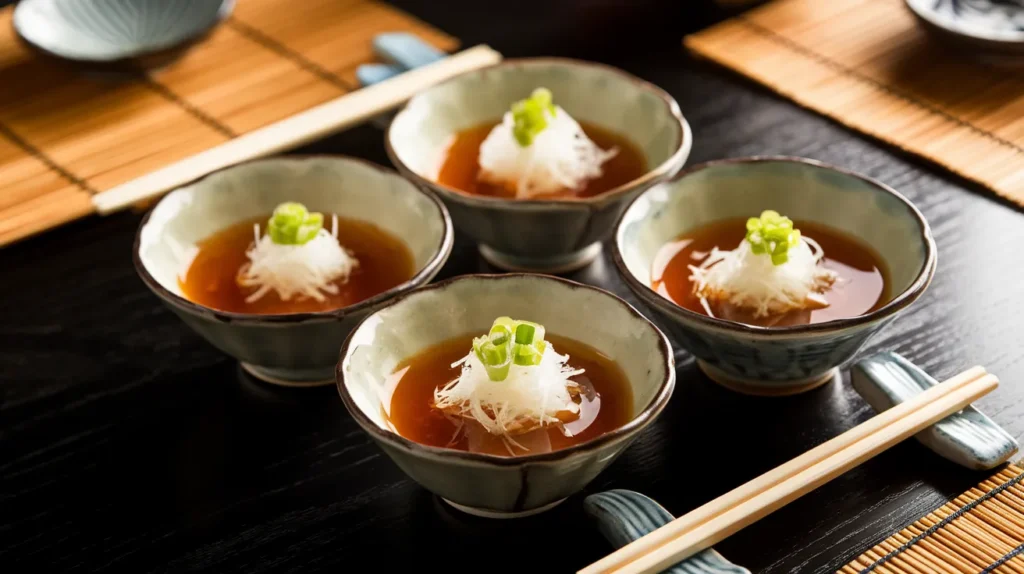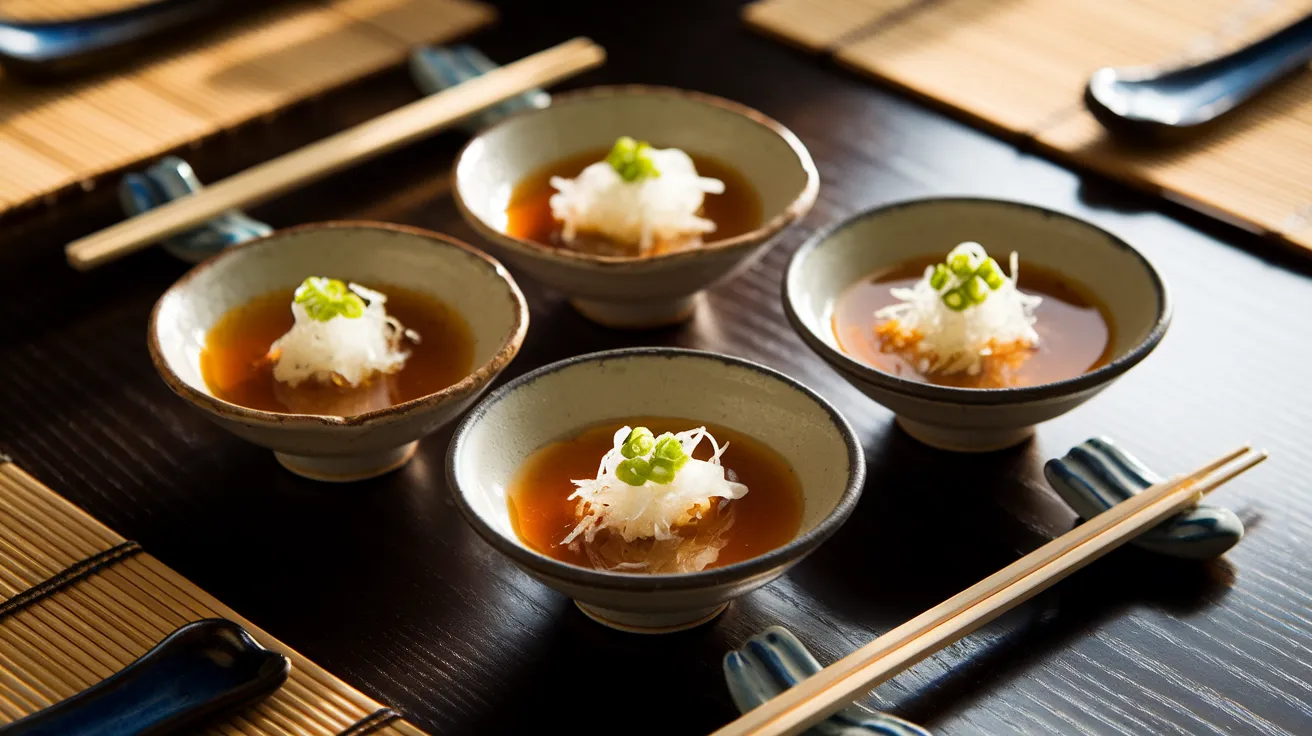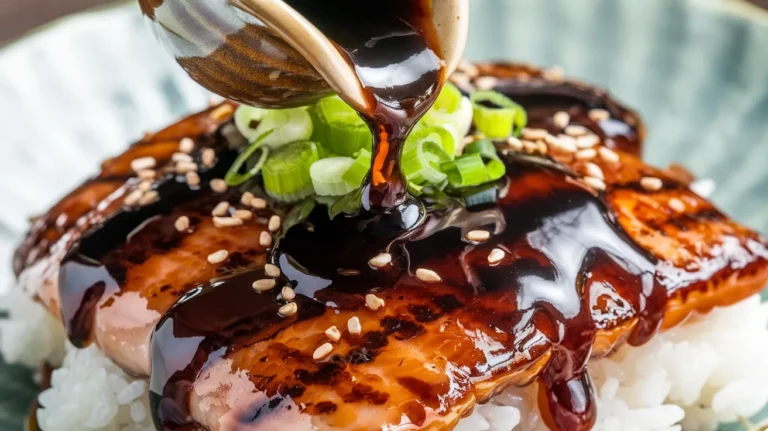This authentic tempura dipping sauce brings restaurant-quality flavor to your homemade tempura with just four simple ingredients. Our tempura dipping sauce recipe creates the perfect balance of savory, sweet, and umami flavors that complement crispy tempura vegetables and seafood beautifully.
SERVES: 4 | PREP: 5 MIN | COOK: 0 MIN | TOTAL: 5 MIN
Ingredients
Essential Base Ingredients:
| Ingredient | Amount | Notes |
|---|---|---|
| Dashi stock | 1/2 cup | Room temperature or warm |
| Soy sauce | 2 tablespoons | Use Japanese soy sauce for best flavor |
| Mirin | 2 tablespoons | Sweet rice wine |
| Sugar | 1 teaspoon | Granulated white sugar |
Optional Garnishes:
- Fresh grated daikon radish (2 tablespoons)
- Grated fresh ginger (1/2 teaspoon)
- Finely chopped green onions (1 tablespoon)
Step-by-Step Instructions
Phase 1: Preparing the Base (2 minutes)
Step 1: Gather all ingredients and measure them precisely. Why this matters: Tempura dipping sauce relies on perfect balance – even small measurement errors can throw off the flavor profile.
Step 2: Pour the dashi stock into a medium mixing bowl. Temperature tip: Room temperature dashi works perfectly, but slightly warm dashi (not hot) helps dissolve the sugar faster.
Step 3: Add the soy sauce to the dashi stock. Visual cue: The mixture should turn a rich amber color immediately.
Phase 2: Balancing the Flavors (2 minutes)
Step 4: Pour in the mirin slowly while stirring gently with a whisk or spoon. Technique note: Gradual mixing prevents any separation and ensures even flavor distribution.
Step 5: Add the sugar and stir continuously for 30 seconds until completely dissolved. Success indicator: No sugar granules should be visible, and the sauce should look smooth and glossy.
Step 6: Taste the tempura dipping sauce and adjust if needed. Flavor balance: You should taste salty (soy sauce), sweet (mirin and sugar), and umami (dashi) in equal proportions.
Phase 3: Final Preparation (1 minute)
Step 7: If using fresh garnishes, grate the daikon radish using the finest setting on your grater. Pro tip: Squeeze excess moisture from daikon to prevent watering down the sauce.
Step 8: Add grated ginger if desired – start with just a pinch and taste before adding more. Warning: Fresh ginger is potent and can overpower the delicate balance.
Step 9: Transfer to individual small bowls for serving. Serving size: About 2-3 tablespoons per person is perfect for dipping.
Step 10: Garnish each bowl with a small mound of grated daikon and a sprinkle of green onions if using.
Chef’s Notes
Dashi Quality Matters: The foundation of exceptional tempura dipping sauce starts with quality dashi. Homemade dashi creates superior flavor, but high-quality instant dashi powder works well for convenience.
Mirin Substitution: If mirin isn’t available, substitute with 2 tablespoons rice vinegar plus 1 teaspoon sugar, though authentic mirin provides irreplaceable complexity.
Make-Ahead Advantage: This tempura dipping sauce actually improves after 30 minutes as flavors meld together, making it perfect for meal prep.
Temperature Preference: Serve at room temperature for best flavor experience – cold sauce numbs the taste buds while hot sauce competes with warm tempura.
Nutrition Information (Per Serving)
- Calories: 25
- Protein: 1g
- Carbohydrates: 5g
- Fat: 0g
- Sodium: 580mg
Creative Variations
Spicy Tempura Sauce: Add 1/4 teaspoon shichimi togarashi (Japanese seven spice) for heat and complexity that pairs beautifully with vegetable tempura.
Citrus-Enhanced Version: Include 1 teaspoon fresh yuzu juice or lemon juice for brightness – perfect for seafood tempura and lighter dishes.
Rich Umami Style: Double the dashi concentration and add 1/2 teaspoon bonito flakes for deeper flavor. This variation works wonderfully with our ramen tare techniques for layered umami.
Sweet Soy Variation: Increase mirin to 3 tablespoons and add 1/2 teaspoon honey for a sweeter profile that complements our sukiyaki sauce family of recipes.
Storage & Reheating
Refrigerator Storage: Store tempura dipping sauce in an airtight container for up to one week. The flavors actually develop and improve over the first 2-3 days.
Freezing Guidelines: This sauce doesn’t freeze well due to the dashi base, which can separate and lose flavor complexity when thawed.
Serving from Storage: Always bring to room temperature before serving. Cold sauce masks the delicate flavor balance you’ve worked to achieve.
Freshness Indicators: Discard if you notice any off odors, cloudiness, or separation that doesn’t resolve with gentle stirring.

Troubleshooting Guide
Problem: Sauce tastes too salty Solution: Add 1 tablespoon more dashi and 1/2 teaspoon sugar to rebalance. Taste gradually – it’s easier to add than subtract.
Problem: Sauce seems too sweet Solution: Add 1/2 teaspoon additional soy sauce and a pinch of salt. The umami will counter excess sweetness effectively.
Problem: Sauce lacks depth of flavor Solution: Your dashi might be too weak. Add 1/4 teaspoon instant dashi powder or use stronger homemade dashi next time.
Problem: Sauce appears cloudy or separated Solution: Whisk vigorously for 30 seconds. If separation persists, your mirin may be past its prime – replace and remake.
Problem: Sauce tastes flat or one-dimensional Solution: Add a tiny amount of rice vinegar (1/4 teaspoon) to brighten flavors, or increase the dashi for more umami complexity.
Equipment Essentials
- Medium mixing bowl (for easy stirring and measuring)
- Whisk or mixing spoon (for smooth blending)
- Fine-mesh grater (for fresh daikon and ginger)
- Small serving bowls (traditional ceramic bowls work best)
- Measuring spoons and cups (precision matters for balance)
Shopping List
Asian Grocery Section:
- Dashi stock or dashi powder
- Mirin (sweet rice wine)
- Japanese soy sauce
Produce Section:
- Fresh daikon radish
- Fresh ginger root
- Green onions
Pantry Staples:
- Granulated sugar
Success Secrets
1. Always taste and adjust your tempura dipping sauce before serving – humidity and ingredient variations can affect the final balance.
2. Make the sauce 30 minutes ahead when possible to allow flavors to harmonize and develop full complexity.
3. Use Japanese ingredients when available – the flavor profiles are specifically designed for this type of sauce and create authentic results.
4. Keep garnishes simple and fresh – they should enhance, not compete with, the carefully balanced base sauce.
5. Serve in small individual bowls to maintain proper sauce-to-tempura ratios and prevent cross-contamination during shared meals.




